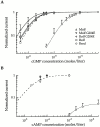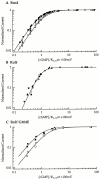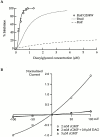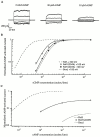Mutation of a single residue in the S2-S3 loop of CNG channels alters the gating properties and sensitivity to inhibitors
- PMID: 11099346
- PMCID: PMC2231820
- DOI: 10.1085/jgp.116.6.769
Mutation of a single residue in the S2-S3 loop of CNG channels alters the gating properties and sensitivity to inhibitors
Abstract
We previously found that native cyclic nucleotide-gated (CNG) cation channels from amphibian rod cells are directly and reversibly inhibited by analogues of diacylglycerol (DAG), but little is known about the mechanism of this inhibition. We recently determined that, at saturating cGMP concentrations, DAG completely inhibits cloned bovine rod (Brod) CNG channels while only partially inhibiting cloned rat olfactory (Rolf) channels (Crary, J.I., D.M. Dean, W. Nguitragool, P.T. Kurshan, and A.L. Zimmerman. 2000. J. Gen. Phys. 116:755-768; in this issue). Here, we report that a point mutation at position 204 in the S2-S3 loop of Rolf and a mouse CNG channel (Molf) found in olfactory epithelium and heart, increased DAG sensitivity to that of the Brod channel. Mutation of this residue from the wild-type glycine to a glutamate (Molf G204E) or aspartate (Molf G204D) gave dramatic increases in DAG sensitivity without changing the apparent cGMP or cAMP affinities or efficacies. However, unlike the wild-type olfactory channels, these mutants demonstrated voltage-dependent gating with obvious activation and deactivation kinetics. Interestingly, the mutants were also more sensitive to inhibition by the local anesthetic, tetracaine. Replacement of the position 204 glycine with a tryptophan residue (Rolf G204W) not only gave voltage-dependent gating and an increased sensitivity to DAG and tetracaine, but also showed reduced apparent agonist affinity and cAMP efficacy. Sequence comparisons show that the glycine at position 204 in the S2-S3 loop is highly conserved, and our findings indicate that its alteration can have critical consequences for channel gating and inhibition.
Figures









Similar articles
-
Mechanism of inhibition of cyclic nucleotide-gated ion channels by diacylglycerol.J Gen Physiol. 2000 Dec;116(6):755-68. doi: 10.1085/jgp.116.6.755. J Gen Physiol. 2000. PMID: 11099345 Free PMC article.
-
A point mutation in the pore region alters gating, Ca(2+) blockage, and permeation of olfactory cyclic nucleotide-gated channels.J Gen Physiol. 2000 Sep;116(3):311-26. doi: 10.1085/jgp.116.3.311. J Gen Physiol. 2000. PMID: 10962010 Free PMC article.
-
Mechanism of tetracaine block of cyclic nucleotide-gated channels.J Gen Physiol. 1997 Jan;109(1):3-14. doi: 10.1085/jgp.109.1.3. J Gen Physiol. 1997. PMID: 8997661 Free PMC article.
-
Calcium/calmodulin modulation of olfactory and rod cyclic nucleotide-gated ion channels.J Biol Chem. 2003 May 23;278(21):18705-8. doi: 10.1074/jbc.R300001200. Epub 2003 Mar 7. J Biol Chem. 2003. PMID: 12626507 Review.
-
Cyclic nucleotide-gated ion channels.Physiol Rev. 2002 Jul;82(3):769-824. doi: 10.1152/physrev.00008.2002. Physiol Rev. 2002. PMID: 12087135 Review.
Cited by
-
Electrophysiological analysis of cloned cyclic nucleotide-gated ion channels.Plant Physiol. 2002 Feb;128(2):400-10. doi: 10.1104/pp.010832. Plant Physiol. 2002. PMID: 11842144 Free PMC article.
-
All-trans-retinal is a closed-state inhibitor of rod cyclic nucleotide-gated ion channels.J Gen Physiol. 2004 May;123(5):521-31. doi: 10.1085/jgp.200409011. Epub 2004 Apr 12. J Gen Physiol. 2004. PMID: 15078915 Free PMC article.
-
Mechanism of inhibition of cyclic nucleotide-gated ion channels by diacylglycerol.J Gen Physiol. 2000 Dec;116(6):755-68. doi: 10.1085/jgp.116.6.755. J Gen Physiol. 2000. PMID: 11099345 Free PMC article.
-
Sensitivity of HCN channel deactivation to cAMP is amplified by an S4 mutation combined with activation mode shift.Pflugers Arch. 2009 Sep;458(5):877-89. doi: 10.1007/s00424-009-0687-6. Epub 2009 Jun 21. Pflugers Arch. 2009. PMID: 19544068
References
-
- Biel M., Altenhofen W., Hullin R., Ludwig J., Freichel M., Flockerzi V., Dascal N., Kaupp U.B., Hofmann F. Primary structure and functional expression of a cyclic nucleotide-gated channel from rabbit aorta. FEBS Lett. 1993;329:134–138. - PubMed

